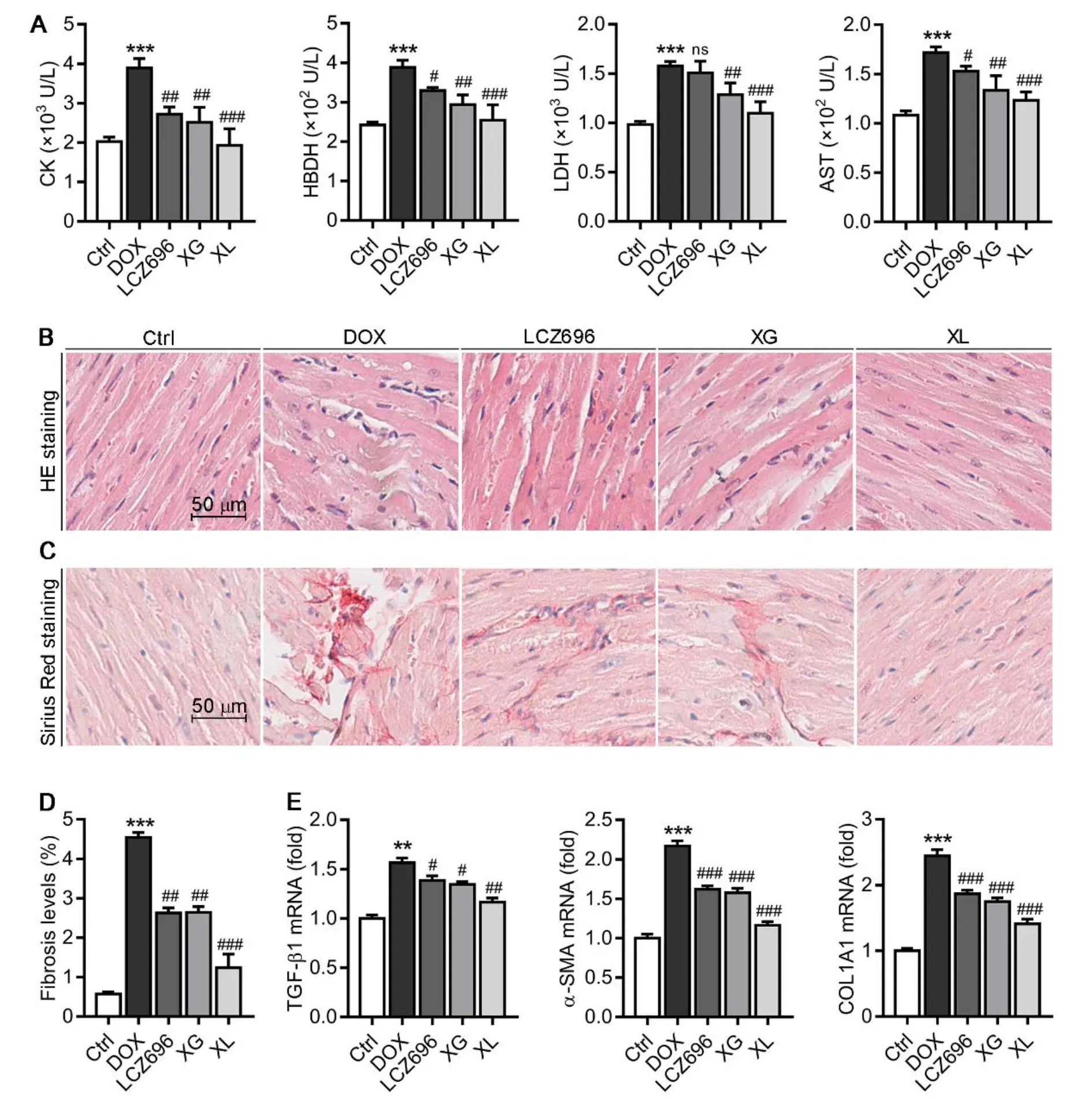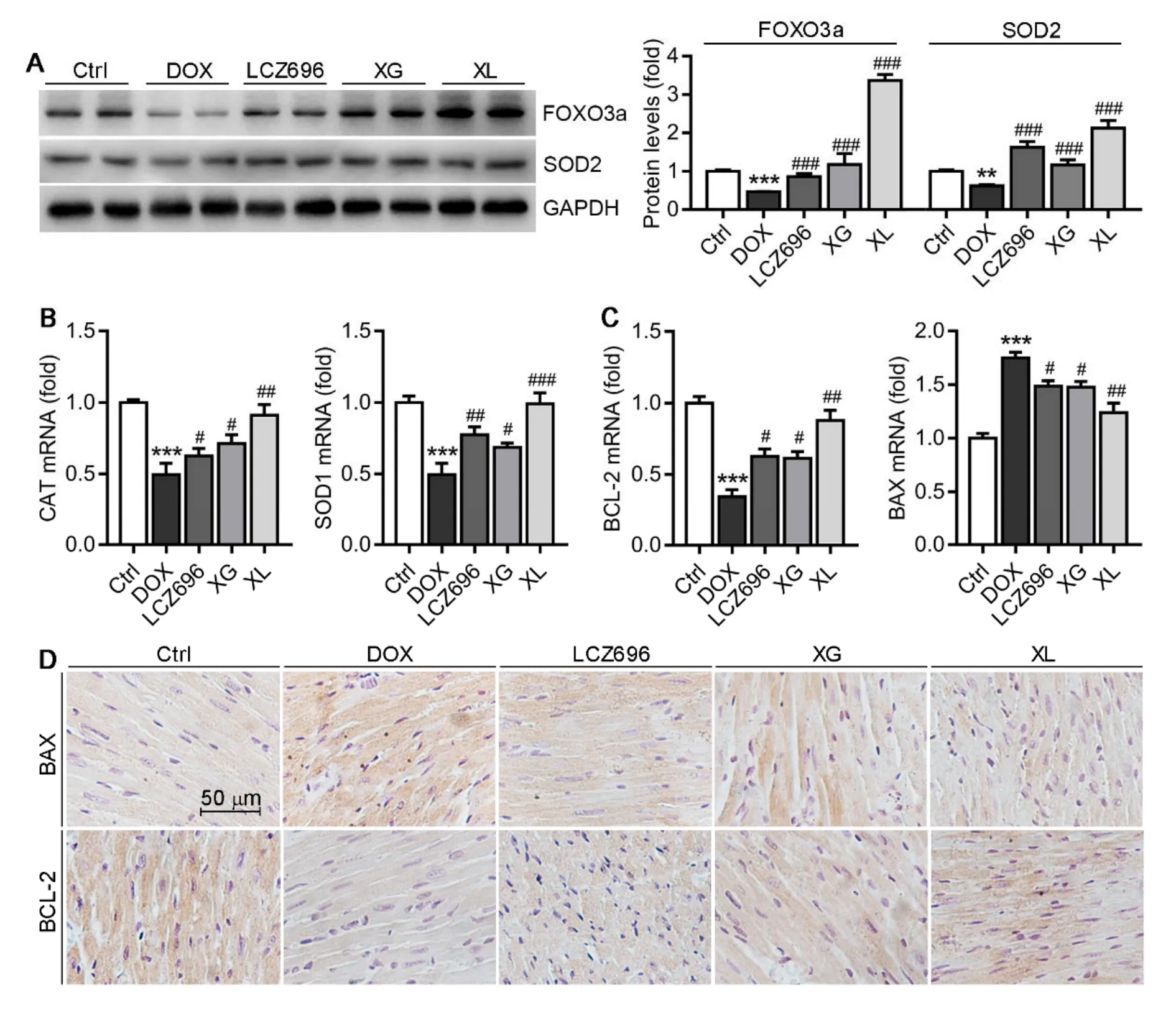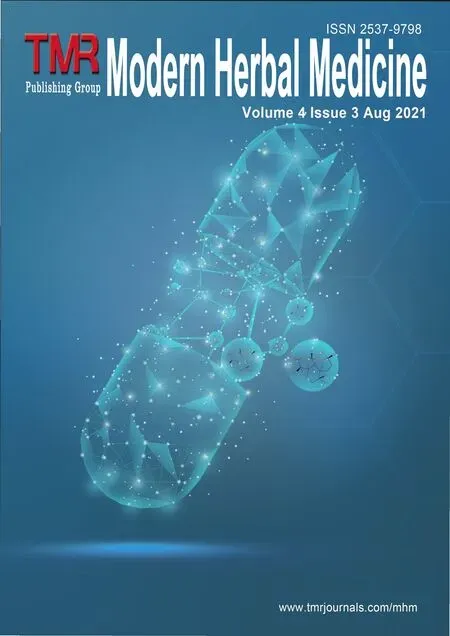Combination of XianGui capsule and LCZ696 inhibits doxorubicininduced heart failure in mice
Yuanyu Wang,Rong Huang,Jihong Han,2,Xiaoxiao Yang,Yajun Duan,*
1 Department of Pharmacological Sciences,Key Laboratory of Metabolism and Regulation for Major Diseases of Anhui Higher Education Institutes,College of Food and Biological Engineering,Hefei University of Technology,Hefei,China;
2 Department of Biochemistry and Molecular Biology,College of Life Science,Key Laboratory of Bioactive Materials of Ministry of Education,State Key Laboratory of Medicinal Chemical Biology,Nankai University,Tianjin,China.
Abstract Objective:We used doxorubicin(DOX)-induced heart failure mouse model to investigate the therapeutic effect and involved mechanism of XianGui capsule(XG)combined with Sacubitril Valsartan Sodium tablets(LCZ696)on heart failure.Methods:C57BL/6 mice were divided into control(Ctrl)group,DOX group,XG group,LCZ696 group and combination(XL)group.After the administration,mice heart functions,blood pressure,and serum cardiac injury markers were detected.Heart sections were conducted with HE,Sirius Red and immunohistochemical staining.The heart tissues were collected for the determination of protein or mRNA expression of antioxidative,fibrosis,inflammation and apoptosis-related genes by Western Blot and qRT-PCR.Results:XG,LCZ696 or XG plus LCZ696 can significantly improve the heart functions of mice,reduce the expression of cardiac injury markers,and inhibit myocardial fibrosis.Mechanically,XG,LCZ696 or their cotreatment antagonized myocardial apoptosis,increase forkhead box O3a,superoxide dismutase 2(SOD2)protein,SOD1,catalase mRNA expressions and inhibited the protein and mRNA levels of toll-like 4,nuclear factor κB,and inflammatory cytokines.Conclusion:XG,LCZ696 or XG plus LCZ696 decreases DOX-induced cardiomyocytes apoptosis by reducing inflammatory factors and enhancing expression of antioxidant enzymes,thereby alleviating the development of heart failure.
Keywords:XianGui capsule,Sacubitril Valsartan Sodium tablets(LCZ696),Heart failure,Doxorubicin,Inflammation
Background
Heart failure occurs in the final stages of various heart diseases.Its morbidity and mortality are high,resulting in frequent hospitalizations that will greatly reduce the quality of life of patients.About 25 years ago,heart failure was first called an emerging epidemic.So far,the diagnosis rate of heart failure worldwide is still on the rise[1].At present,the number of patients suffering from heart failure is as high as 65 million.Heart failure has rapidly developed into a serious public hazard in more than 20 years[2].The increasing number of patients with heart failure is related to the increase in the global population,the aging society,the difficulty of controlling related diseases such as hypertension,coronary heart disease,obesity and diabetes,and the increase in the survival time of patients with heart failure[3].
XianGui capsule(XG)is composed of 10 kinds of ultrafine powders of traditional Chinese medical(TCM)herbs such as Hongshen(Panax ginseng),Zhishi(Citrus aurantium),Mahuang(Ephedra sinica Stapf),Guizhi(Cinnamomum cassia),Dihuang(Rehmanniaglutinosa),Maidong(Ophiopogon japonicus),Luoshiteng(Trachelospermum)Xianhecao(Agrimoniapilosu Ledeb),Ejiao(Equus asinm)and Tianma(Gastrodia elata),which has excellent antihypotension effects.These components can antagonize the oxidative stress,inflammation,and apoptosis of cardiomyocytes caused by various heart diseases[4-6].However,whether XG can prevent heart failure remains unknown.LCZ696(Sacubatril and Valsartan Sodium Tablets)is a new type of angiotensin receptor neprilysin inhibitor,which can significantly improve patient symptoms and quality of life[7].However,clinical investigations and studies have shown that compared with enalapril,it can cause side effects,such as hypotension.

Table 1.qRT-PCR primer sequences
TCM has been treating heart failure for hundreds of years.TCM can target multiple channels to improve therapeutic effects.Considering the protective effects of XG on the treatment of hypotension,the combination of LCZ696 and XG is expected as a new type of therapy for the treatment of heart failure.In this work,we compared the therapeutic effects of XG and LCZ696 and also investigated the mechanism of the combination in the treatment DOX-induced heart failure.
Materials and methods
Materials
XG and LCZ696 were provided by Buchang Pharmaceutical Co,Ltd(Shan’xi,China).DOX was obtained from MedChemExpress(Monmouth Junction,New Jersey,USA).Rabbit anti-B-cell lymphoma 2(BCL-2,12789-1-AP),BCL-2 associated X protein(BAX,50599-2-lg),forkhead box O3a(FOXO3a,10849-1-AP)antibodies,goat anti-rabbit lgG(H+L)-HRP(LK2001),goat anti-mouse lgG(H+L)-HRP(LK2003)and rabbit anti-toll-like 4(TLR4,19811-1-AP)were obtained from Proteintech Group,Inc(Chicago,Illinois,USA).Mouse anti-glyceraldehyde-3-phosphate dehydrogenase(GAPDH,AC033),rabbit anti-NF-κB(A16271)and SOD2(A1340)antibodies were obtained from Abclonal(Wuhan,Hubei,China).Cocktail,PMSF and enhanced chemiluminescence kits were obtained from Millipore(Darmstadt,Hesse-Darmstadt,Germany).Total RNA extraction reagent(Trizol,ZP401-2)was obtained from Beijing Zomen Biotechnology Co.Ltd(Beijing,China).cDNA synthesis kit was obtained from Vazyme(Nanjing,Jiangsu,China).SYBR green PCR master mix was obtained from Roche(Basel,Basel-Stadt,Switzerland).
Animals
The Institution Animal Ethics Committee of Hefei University of Technology approved the animal experiments for this study,and conformed to the Guide for the Care and Use of Laboratory Animals published by the National Institute of Health(NIH Publications No.8023,revised 1978).
Adult male C57BL/6 mice(6~8 weeks old,~22 g)were obtained from Beijing Vital River Laboratory Animal Technology Co.,Ltd.Totally 40 mice were divided into 5 groups by random number table method as following:Control group(Ctrl),and intraperitoneally(i.p.)injected saline(100 μl/mice)and fed normal chow;DOX group(DOX),i.p.injected DOX(5 mg/kg bodyweight)once a week for consecutive 4 weeks and fed normal chow[8];LCZ696-treated group(LCZ696),i.p.injected DOX weekly and received oral gavage of LCZ696(60 mg/kg bodyweight,100 μl/mice)daily for 4 weeks[9];XGtreated group(XG),fed normal chow containing XG(2 g/kg bodyweight)and i.p.injected DOX weekly for 4 weeks;XL-treated group(XL),fed normal chow containing XG(2 g/kg bodyweight),received oral gavage of LCZ696(60 mg/kg bodyweight,100 μl/mice)daily and i.p.injected DOX weekly for 4 weeks.After administration,40 mice were performed echocardiographic and blood pressure measurements.
Biomarkers of heart damage
Serum was conducted aspartate aminotransferase(AST),serum lactate dehydrogenase(LDH),creatine kinase(CK)and hydroxybutyrate dehydrogenase(HBDH)levels by automatic biochemical analyzer[8](Model 7020;Hitachi,Tokyo,Japan).
Echocardiography
The transthoracic echocardiography of mice was recorded by an animal specific ultrasound apparatus(VINNO6 System)to assessed cardiac function.The mice were anesthetized with 3% isoflurane/oxygen mixture and placed supine on a platform with constant temperature of 37℃.The M-mode echocardiograms of each group were detected by the probe and recorded in the imaging platform.Left ventricular ejection fraction(EF)and fraction shortening(FS)calculation were based on echocardiographic data[10].
Blood pressure measurement
Blood pressure(BP)was measured by tail-cuff method.At the 31stday of treatment,we conducted blood pressure test.The systolic blood pressure(SBP)and diastolic blood pressure(DBP)of mice were recorded using noninvasive blood pressure analysis system(BP-2000;Visitech Systems,USA).Prior to measurement,mice were restrained in a constant temperature platform at 35°C.After stabilizing for 10 minutes,place the cuff on the tail,measure the blood pressure 15 times in each mouse,and pressure values measured as the mean of 5 measurement at least.
Histological analysis
Mice heart tissues were fixed and dehydrated with 4%paraformaldehyde.After 24 hours,the tissue was embedded in paraffin and processed into 5 μm-sections using a slicing platform.The sections were conducted with hematoxylin/eosin(HE)staining to analyze the injury of heart tissues.The sections were conducted with Picrosirius Red to analyze myocardial fibrosis[11].Determination of the levels of BAX and BCL-2 in heart tissue sections by immunohistochemical staining[12].
Western blot and quantitative real-time PCR(qRTPCR)
Total protein was obtained from mice heart tissues and determined expression of FOXO3a,GAPDH,NF-κB,SOD2 and TLR4 protein by Western blot as previously described[13].Total RNA was obtained from mice heart tissues,cDNA was synthesized with RT SuperMix and mRNA expression was determined by real-time PCR with SYBR green master mix.The primer sequences used in this work are shown in Table 1.Levels of BAX,BCL-2,catalase(CAT),collagen type I alpha 1(COL1A1),interleukin 1β(IL-1β),IL-6,IL-10,α smooth muscle actin(α-SMA),SOD1,transforming growth factor β1(TGF-β1)and tumor necrosis factor(TNF-α)mRNA was normalized by βactin mRNA in the corresponding samples.
Data analysis
Experimental data were collected from independent experiments and repeated at least 3 times,and only representative results were listed.Dates expressed as mean ± standard error of mean(SEM).GraphPad Prism 7.0 software was used to analyze and statistic the experimental results.One-way ANOVA was used to analyze the relevant data.Differences associated withP< 0.05 were considered statistically significant.
Results
Combination therapy improves heart function and regulates blood pressure in mice
Accumulating evidence indicates that the active ingredients in XG can effectively inhibit oxidative stress,inflammation,and apoptosis of cardiomyocytes in various heart diseases[4-6,14-16].LCZ696 is extensively used to treat heart failure in clinic.However,LCZ696 may cause some side effects,such as hypotension.To determine if XG plus LCZ696 can provide additional cardioprotective effects,we used DOX-induced heart failure mouse model and treated mice with XG,LCZ696 or XL as indicated in Figure 1A.At the end of treatment,mouse cardiac functional was evaluated by echocardiography.Mice in DOX group showed abnormal cardiac functional,EF and FS.Both XG and LCZ696 can increase EF and FS significantly,and the increase was more significant by the co-treatment(Figure 1B,C).
Previous studies have shown that LCZ696 has a high risk of low blood pressure in various types of heart failure[17].Considering the anti-hypotensive effect of XG,the combination of XG and LCZ696 may effectively antagonize the side effects of LCZ696.The results of blood pressure showed that SBP and DBP in mice of DOX group were significantly reduced,while mice blood pressure was significantly improved in XG group(Figure 1D).These results showed that XG combined with LCZ696 could antagonize the low blood pressure caused by LCZ696.
Combination therapy attenuates DOX-induced myocardial injury and fibrosis in mice
Serum CK,HBDH,LDH,and AST are classic biomarkers of cardiac injury[18].Compared with control group,CK,HBDH,LDH and AST levels were significantly improved in DOX group,while substantially reduced by XG,LCZ696 or the combination treatment(Figure 2A).
To further determine the protective effect of XG and LCZ696,we conducted HE and Picrosirius Red staining to detect histopathological alterations in heart tissue.HE staining showed that cardiomyocytes in the DOX group were swollen,sparsely arranged.XG,LCZ696 or XG plus LCZ696 treatment substantially reversed these damages.Similarly,Picrosirius Red staining showed that DOX induced obvious myocardial fibrosis with increasement of collagen deposition in the intercellular space.In contrast,those symptoms were clearly blocked by XG,LCZ696 or their co-treatment(Figure 2B-D).

Figure 1.Co-treatment of XG and LCZ696 improves DOX-induced cardiac dysfunction.A:modeling and treatment of heart failure mice;B,C:EF and FS are calculated by echocardiography(C);D:SBP and DBP are recorded by non-invasive blood pressure testing system;***P < 0.001 vs.Ctrl group;#P < 0.05,##P < 0.01,###P <0.001 vs.DOX group(n ≥ 5).

Figure 2.Co-treatment of XG and LCZ696 attenuates DOX-induced myocardial injury and fibrosis by inhibiting pro-fibrosis related gene expression.A:at the end of experiment,extract serum from blood samples to determination of serum CK,HBDH,LDH and AST levels.B-D:heart tissue sections were conducted HE staining(B)and Masson staining(C)with quantitative analysis of fibrosis levels(D);E:mRNA levels of TGF-β1,α-SMA,and COL1A1 in heart tissues were determined by qRT-PCR.**P < 0.01,***P < 0.001 vs.Ctrl group;#P < 0.05,##P < 0.01,###P < 0.001 vs.DOX group(n ≥ 5).
We conducted qRT-PCR to determine expression of TGF-β1,COL1A1 and α-SMA mRNA and found that XG,LCZ696 or their co-treatment significantly reduced mRNA levels of these factors(Figure 2E).These results indicated that the XG and LCZ696 could improve myocardial structure and reduce myocardial fibrosis by decreasing TGF-β1,COL1A1 and α-SMA content in heart tissue.More importantly,these cardioprotective functions are further improved by XG plus LCZ696.
Combination therapy inhibits DOX-induced oxidative stress in mice
Oxidative stress is one of the leading causes of heart failure.FOXO3a has a pivotal role in regulating oxidative injury and maintaining reactive oxygen species(ROS)homeostasis.CAT and SOD1/2 are important antioxidant enzymes regulated by the transcription factor FOXO3a.Therefore,we detected the expression of FOXO3a,SOD2,CAT and SOD1 in heart tissue.Compared with control group,XG,LCZ696 or their co-treatment can effectively inhibit the decrease of FOXO3a and SOD2 protein levels and SOD1 and CAT mRNA expression caused by DOX(Figure 3A,B).
Excessive production of ROS in cardiomyocytes can induce activation of apoptotic pathway[19-21].To confirm whether XG,LCZ696 or their co-treatment could reduce DOX-induced cardiomyocyte apoptosis,we determined the levels of apoptosis-related genes BCL-2 and BAX in the heart tissues by immunohistochemical staining and qRT-PCR.The results showed that expression of BCL-2 was increased,while BAX was reduced by XG,LCZ696 or XG plus LCZ696(Figure 4C,D).
In summary,these results suggest that both XG and LCZ696 inhibits cardiomyocyte apoptotic by enhancing antioxidant enzymes expression and regulating expression of BCL-2 and BAX.These protective functions are further improved by the cotreatment of XG plus LCZ696.
Combination therapy attenuates DOX-induced inflammation and apoptosis in mice
Cardiac inflammation is another vital cause of heart failure.TLR4 and NF-κB have pivotal roles in inflammatory process and are involved in the deterioration of heart failure[22,23].Compared with control group,protein levels of TLR4 and NF-κB in heart tissues of DOX group were significantly increased,but the induction was inhibited by XG,LCZ696 or XG plus LCZ696 treatment(Figure 4A).Similarly,XG,LCZ696 or their co-treatment could significantly reduce mRNA levels of pro-inflammatory factors IL-1β,IL-6,TNF-α and enhance antiinflammatory factor IL-10 in heart tissues.Moreover,the effect of regulating inflammatory factors is more obvious in the XL group(Figure 4B,C).These results indicate that XG,LCZ696 or their co-treatment decreases DOX-induced cardiac inflammation through inhibiting TLR4/NF-κB signaling pathway.

Figure 3.Co-treatment of XG and LCZ696 inhibits DOX-induced oxidative stress and apoptosis-related genes.A:protein content of FOXO3a and SOD2 in heart tissues were detected by Western blot and the bands were quantitatively analyzed;B,C:mRNA expressions of CAT,SOD1(B),BCL-2 and BAX(C)in heart tissues were detected by qRT-PCR;D:immunohistochemical staining to detect the expression of BAX and BCL-2 in heart tissue sections;**P < 0.01,***P < 0.001 vs.Ctrl group;#P < 0.05,##P < 0.01,###P < 0.001 vs. DOX group(n ≥ 5).

Figure 4.Co-treatment of XG and LCZ696 reduces DOX-induced inflammation by inhibiting inflammation cytokines.A:protein expression of TLR4 and NF-κB in heart tissues were detected by Western blot and the bands were quantitatively analyzed;B,C:mRNA expressions of IL-1β,IL-6,TNF-α(B)and IL-10(C)in heart tissues were determined by qRT-PCR;***P < 0.001 vs.Ctrl group;#P < 0.05,##P < 0.01,###P < 0.001 vs. DOX group(n ≥5).
Discussion
DOX is a highly effective and broad-spectrum anticancer medicine.Severe cardiotoxicity limits the use of DOX.In fact,some studies have suggested that cardiotoxicity of DOX can lead to death in patients[24].DOX is used wildly to construct heart failure mouse model with the poterity of cardiotoxicity.In this study,we observed that XG,LCZ696 or XG plus LCZ696 significantly improved DOX-induced heart failure in mice by inhibiting fibrosis,oxidative stress,inflammation and apoptosis.
XG is composed of multiple TCM containing various active substances.These substances contain many active ingredients,such asRehmannia glutinosairidoid glycosides,Rehmannia glutinosasaccharides,Ophiopogonjaponicussteroidal saponins,Ophiopogon japonicushomoisoflavonoids,Ophiopogonjaponicuspolysaccharides saponins,Gastrodin,Ginsenoside,Citrus aurantiumflavonoids,Citrus aurantiumalkaloid,Cinnamomum cassiaterpenoids,Cinnamomum cassiaphenylpropanoids,Cinnamomumcassiaglycosides,Trachelospermumlignans,Trachelospermumtriterpenoids,Trachelospermumflavonoids,Agrimonia pilosu Ledebflavonoids andEphedra sinica Stapfpolysaccharide[25-33].Recent researches have shown that these active substances have cardioprotective effects.For example,Rehmannia glutinosacan relieve the oxidative stress,lipid peroxidation and apoptosis of H9C2 cells induced by DOX[4].Ophiopogon japonicussteroidal saponins can improves DOX-induced heart failure by inhibiting oxidative stress and inflammation[5].Ophiopogon japonicuspolysaccharide can against myocardial injury caused by isoproterenol[6].Gastrodin clearly relieves myocardial ischemia/reperfusion injury in mice by enhancing autophagy flux[34].In this work,we suggest that XG relieves DOX-induced heart failure by inhibiting oxidative stress,inflammation and apoptosis.
Oxidative stress can promote heart failure development[35].FOXO3a is a transcription factor that is sensitive to intracellular ROS levels.It has the function of FOXO3a plays a crucial role in controlling mitochondrial metabolism and maintaining redox balance by regulating anti-oxidation enzymes expression[36].Our research showed that XG,LCZ696 or XG plus LCZ696 inhibit oxidative stress by increasing FOXO3a levels and downstream molecules SOD1,SOD2 and CAT(Figure 3A,B).
TLR4/NF-κB is a classic inflammatory signal pathway.TLR4 is a type of specific receptor involved in the immune response.Activated TLR4 can activate NF- B through a cascade reaction.Subsequently,NF
B enters the nucleus to induce the expression of inflammatory cytokines,IL-1β,IL-6 and TNF-α[37-39].Therefore,inhibiting the activation of TLR4/NFκB signaling pathway can exert anti-inflammatory effects and relieve heart injury.We found that XG,LCZ696 or their co-treatment can regulate mRNA expressions of IL-1β,IL-6,TNF-α and IL-10(Figure 4B,C)by inhibiting TLR4 and NF-κB levels in DOXinduced cardiac inflammation(Figure 4A).
Both oxidative stress and myocardial inflammation can cause damage to cells,leading to mitochondrial dysfunction and eventually cause abnormal apoptosis[40].Mitochondria are the main targets of acute and long-term oxidative stress in heart failure.Oxidative stress causes damage to mitochondrial membrane,and activate apoptosis signaling pathways[41].BAX and BCL-2 are key factors in initiation of apoptosis program[42].Our results showed that XG,LCZ696 or XG plus LCZ696 can alleviate DOX-induced heart failure by enhancing BCL-2 level and reducing BAX level(Figure 3C,D).
Conclusion
We demonstrate that XG,LCZ696 or XG plus LCZ696 can alleviate DOX-induced heart failure.Meanwhile,this study shows that XG ameliorates LCZ696-induced hypotension,suggesting a potential clinical application for heart failure treatment.
 TMR Modern Herbal Medicine2021年3期
TMR Modern Herbal Medicine2021年3期
- TMR Modern Herbal Medicine的其它文章
- Effects and safety of Ding Kun Dan on lVF/lCSl-ET outcomes in patients with predicted poor ovarian response:A multicenter randomized clinical trial
- Pharmaceutical care of a patient with antibiotic-associated encephalopathy
- Research of the clinical efficacy of Qiming Granule in treatment of diabetic nephropathy by meta-analysis
- Progress of ubiquitin-proteasome system in the pathophysiology of heart failure and the intervention of traditional Chinese medicine
- Extraction and antibacterial potential of traditional medicinal plant Cypreus compressus
